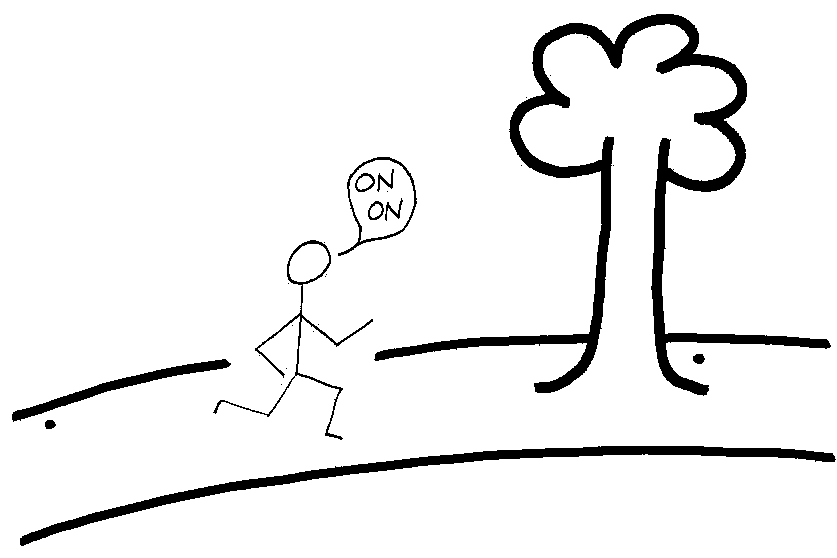Biggles original can be found here
A printer friendly version of this document can be downloaded here
"Hare Ye Well"
The Responsibilities of the Hare
The essence of hashing is to enjoy a social run in the company of others of mixed ability. A cleverly prepared run will ensure that the pack is kept together by tricking the faster front runners with false trails. A hash is not a race! The following notes are meant to act as guidance for new hashers. However, a refresher could benefit us all from time to time.
Below are some quick links to specific subjects, however the article has been written to read straight through.
Introduction
The history of hashing can be found elsewhere (see your GM or On-Sec!). This publication is more about what happens weekly in your local pack.
Most Devon packs look to run trails of about 1 hour, but whatever the preferred run length for your pack, it must be remembered that it should apply to the whole pack - not just the ‘front running b*st*rds’ (FRBs) who could comfortably cover 10 miles in 75mins. A guide distance for an hour would be about 4-5 miles in the summer and 3-4 miles in the winter when running in the dark with torches reduces the pace considerably. Distance will also depend upon the chosen terrain - for example, flat and even footpaths can be covered much quicker than rough and hilly moorland. Within most packs there is a wide cross-section of abilities so the Hares need to be especially devious in order to keep the pack together. This is fundamental to Hashing, as it is a social, group activity and not meant as a race.
Back to the top
 Choosing a Location
You will need to be aware of where you can and can’t go. Being able to use masses of public footpaths and open spaces is ideal. Often farmers and landowners will permit you to cross or use the edges of their fields [Note: failure to ask for permission may compromise future runs in that area]. Also look for choices of direction – a coastal footpath or beach is all very well but can be limiting when it comes to placing checks.
Ideally choose a pub to run from or alternatively a FREE car park that is easy to find, and within your agreed hashing area. Your Hare Master will advise you of your usual area. Consider the weather. Is it really wise to head for High Dartmoor in the winter? Once chosen stick to your venue – contradictions in the various publications cause confusion!
Choosing a Location
You will need to be aware of where you can and can’t go. Being able to use masses of public footpaths and open spaces is ideal. Often farmers and landowners will permit you to cross or use the edges of their fields [Note: failure to ask for permission may compromise future runs in that area]. Also look for choices of direction – a coastal footpath or beach is all very well but can be limiting when it comes to placing checks.
Ideally choose a pub to run from or alternatively a FREE car park that is easy to find, and within your agreed hashing area. Your Hare Master will advise you of your usual area. Consider the weather. Is it really wise to head for High Dartmoor in the winter? Once chosen stick to your venue – contradictions in the various publications cause confusion!
Back to the top
 Choosing the Pub
Arguably the most important task that a hare undertakes is to choose a suitable pub for the ‘On-Down’ or ‘On-Inn’.
First on the list is the refreshments. Many hashers are ‘real ale’ enthusiasts, so a good selection of beers is essential if you are not to get lynched!! As for food, roughly half the pack seem to buy meals if the price is right. If it’s too expensive fewer will eat. Hashers are not a fussy bunch and will be easily pleased by a chilli, curry or something similar with a price around the £4.00 mark. The usual bar meal menu might be suitable, or perhaps they might like to put on a special hash menu to make things easier and perhaps cheaper. Don’t forget a veggie option!
Secondly, the pub must be willing to have us and be big enough to accommodate the expected numbers without upsetting the regulars! The near impossible has been achieved on the odd occasion (90+ in the tiny Rugglestone at Widecombe in the Moor), but usually a more roomy venue is expected, especially during the winter, when sitting outside is not an option. Give them at least a weeks notice of the intended visit and expected arrival times will also help. Don’t forget to mention the initial bar rush when we first arrive!
Thirdly, is there enough space in the car park or on roads close by for parking? Avoid upsetting the local residents by taking up all the street parking.
Fourth on the list comes the beer for the Down-Downs. Many Devon hashes hold a Hash Circle after the run to celebrate anniversaries and events that happened en route. If your pack does, it’s worth asking the publican if he would provide 3 or 4 pints of beer for the Down-Downs at the time of booking the pub. If you tell him it’s for the weekly awards and that it is customary for the pub to supply the beer, then they normally oblige. If they turn you down perhaps another pub should be considered.
Choosing the Pub
Arguably the most important task that a hare undertakes is to choose a suitable pub for the ‘On-Down’ or ‘On-Inn’.
First on the list is the refreshments. Many hashers are ‘real ale’ enthusiasts, so a good selection of beers is essential if you are not to get lynched!! As for food, roughly half the pack seem to buy meals if the price is right. If it’s too expensive fewer will eat. Hashers are not a fussy bunch and will be easily pleased by a chilli, curry or something similar with a price around the £4.00 mark. The usual bar meal menu might be suitable, or perhaps they might like to put on a special hash menu to make things easier and perhaps cheaper. Don’t forget a veggie option!
Secondly, the pub must be willing to have us and be big enough to accommodate the expected numbers without upsetting the regulars! The near impossible has been achieved on the odd occasion (90+ in the tiny Rugglestone at Widecombe in the Moor), but usually a more roomy venue is expected, especially during the winter, when sitting outside is not an option. Give them at least a weeks notice of the intended visit and expected arrival times will also help. Don’t forget to mention the initial bar rush when we first arrive!
Thirdly, is there enough space in the car park or on roads close by for parking? Avoid upsetting the local residents by taking up all the street parking.
Fourth on the list comes the beer for the Down-Downs. Many Devon hashes hold a Hash Circle after the run to celebrate anniversaries and events that happened en route. If your pack does, it’s worth asking the publican if he would provide 3 or 4 pints of beer for the Down-Downs at the time of booking the pub. If you tell him it’s for the weekly awards and that it is customary for the pub to supply the beer, then they normally oblige. If they turn you down perhaps another pub should be considered.
Back to the top
What to use to Mark the Trail
Flour, chalk and sawdust are most commonly used. These are environmentally friendly and easily sourced. Chalk and flour have the advantage of being less bulky, but you may have to buy it. Sawmills, on the other hand, will often give you sawdust free. But, be warned – the sawdust must have come from untreated wood so that it will not to be harmful to animals.
Laying the Trail - The Marks

|
Dot. This is the usual trail marker. The third dot following a Check is usually the correct route, or "On-On". [Note: some packs do not call "On-On" until they have found an arrow].
|

|
Check. Used as often as possible, but at least 3 per mile, to indicate where there is a choice of direction available. For example at road or footpath junctions. Trails will be marked from here in various directions, but usually only one will be the correct route.
|

|
Check-Back. This is used to indicate a false trail from a Check and is usually the third mark; I.E. it follows 2 dots. When you find one you must return to the Check and try again.
|

|
Back-Check. This can appear anywhere along the trail. Simply it means that you left the last check in the correct direction, but you have missed a turning off this route. An arrow to suggest which way you should look to find the correct route sometimes accompanies it.
|

|
Re-Group. 'R' or 'RG' in a circle is used to hold the pack at a point and bring them back together, allowing the back markers time to catch up. This may also be used to allow time to look at a view, or even to have a beer stop! The hare will indicate the 'On-On' from here.
|
Back to the top
Each pack has it’s own variations on the above, but basically the principle remains the same. Long/short splits are usually marked with an ‘L’ and ‘S’ and arrows to indicate direction.
Remember to make your marks clear to avoid confusion and put them where they can be seen. Beyond, but not behind, a tree is a good idea if you don’t want the trail to be found until the last moment.
Example of where to place Dots

Return to "The Marks"
On open country and for night runs you will need to put down more markers. Ideally the next one should be visible from the current one.
If you decide to include long/short splits so that the FRBs can have a longer run, remember the trail must be laid in both dierctions, and marked with an 'L'/'S' as shown here.
Example of use of Long/Short splits

An alternative may be to short cut the back markers as here.
Example of the use of a Short Cut to avoid a Check

Or you may send the front of the pack all around a field (assuming no crops!). As the back of the pack arrives in the field it's obvious where the exit is and so they carry on straight-ahead!
Example of Short Cutting the Back Markers

The Trail
Plan your trail well in advance, preferably with a suitable map!
Always get permission from the landowners and farmers – they may even point you towards some very special terrain! [Note: although much of our terrain is public access land, the owners must be consulted before we visit – there may be some parts they do not want disturbed at various times! A fee may be raised, but this is usually waived if adequate notice is given. See Appendix I for contact details].
Footpaths and bridleways are always favourites – but try not to be too obvious.
Take plenty of flour or sawdust with you. A few sticks of chalk are also useful.
Lay at least 3 checks per mile.
Put down dots at least every 70 metres or so, and try to keep them to the same side of the route. This is particularly important on open country or during the dark winter evenings.
Example of the use of a Check and a Back-Check

Return to "The Marks"
Put in extra loops for the fast members of the pack, or be prepared to short cut the back markers to keep the pack together.
Try to include features like river crossings, shiggy and tunnels.
Example of river crossings
 Avoid too much road and long uphill sections without a regroup or long backcheck.
Avoid damage to hedges and crossing dry stone walls – a stile probably isn’t far away.
Respect ALL crops - remember hay is a valuable feed crop to farmers, don’t trample it!
During torch lit runs, avoid river crossings more than knee deep, and don’t take the trail too close to the edge of cliffs, quarries etc. Summer is different!
If you bring the outward trail close to the homeward trail remember to place check backs so they can be seen from both directions. It’s as bad to find you’re On-Home early as it is to find you’re running the outward route again!
Example of the use of Check-Backs
Avoid too much road and long uphill sections without a regroup or long backcheck.
Avoid damage to hedges and crossing dry stone walls – a stile probably isn’t far away.
Respect ALL crops - remember hay is a valuable feed crop to farmers, don’t trample it!
During torch lit runs, avoid river crossings more than knee deep, and don’t take the trail too close to the edge of cliffs, quarries etc. Summer is different!
If you bring the outward trail close to the homeward trail remember to place check backs so they can be seen from both directions. It’s as bad to find you’re On-Home early as it is to find you’re running the outward route again!
Example of the use of Check-Backs

Return to "The Marks"
An alternative to the usual ‘3 dots and On’ rule is to lay ‘1 dot and On’. This is especially good when setting live trails, but can also be used for pre-laid trails. After each check the pack can be called "On-On" at the first dot, as there are no false trails. However, this dot may not necessarily be easy to find as could be up to 100 metres from the check!
Example of a 'One and On' trail

Back to the top
The Calls
So that the following hashers know what’s happening there are a series of calls used. The first is "On-On" - called when you think you’re on the correct trail. "Checking" is called when a check is found, and this is followed by "On-One" at the first dot, "On-Two" at the second dot and, hopefully, "On-On" at the third dot (assuming a ‘3 dots and On’ trail). "On-Back" is shouted to recall hashers from the wrong direction. If a cross is found then the call is "Check Back", and if the cross is in a circle the call is "Back Check" accompanied by "Left" or "Right" if the hare has marked it. The following hashers to those doing the checking call "Are you?" – anything else can cause confusion for those checking.
Back to the top
Running the Trail
There should always be at least two hares. One to keep an eye on the main pack and one to stay with the back markers – the sweeper. This way no one should get lost! At each check it is the responsibility of the hares to see that the correct trail is marked. This can be done either by ‘kicking out’ or breaking the check in the direction of the trail, or laying further marks to enable any late arrivals to follow the trail without checking and hopefully catch the pack up!
Back to the top
And Finally
Don’t attempt to lay a trail on your own, especially your first trail. Experience will avoid the trail being too long or too short, and there will always be someone available to help you. If you use any different markings don’t forget to advise the pack at the start of the hash. Also use this opportunity to advise the pack of any other hazards such as live-stock and busy roads. The hares may also be responsible for the electing of a scribe and this is best done before the run. Check this out with your Hare Master.
Remember hashing is fun. Good luck!
Appendix I - Landowner Contacts
Contacts for major landowners in Devon. Please use these numbers – we do not want to be banned!
Forestry Commission – 01392 832262
National Trust – 01392 881691
Please Email Buzby if these numbers prove to have changed.
Return to The Trail
Back to the top
Appendix II - Quick Check List
As way of a final word, here’s a list to help jog your memory:
Have you chosen a good running area with lots of choice of terrain?
Have you asked permission of the landowner if it’s not public access?
If your route uses a footpath that crosses farmland, have you told the landowner?
Is there a good pub close by?
Does the pub serve a good choice of beer and wine?
Does the pub serve good affordable food?
Does the pub have a good-sized car park, or is there one close by?
Have you told the Publican we’re coming and approximately when?
Have you asked about the Down-Downs (where applicable)?
Have you got enough flour / sawdust / chalk to lay the trail?
If you can answer ‘Yes’ to all the above it will surely be a great trail! And remember, the more checks you use the better – never miss an opportunity to slow the FRBs down and make them work to find the trail you’ve so painstakingly planned and laid!
A printer friendly version of this document can be donwloaded here
Back to the top
This is a Buzby Publication (copyright) based on the 1990 Biggles original.
Issue 1 - November 1999
Suggestions for changes or improvements should be referred to Buzby at:
Telephone: 01392 879600 or Email












